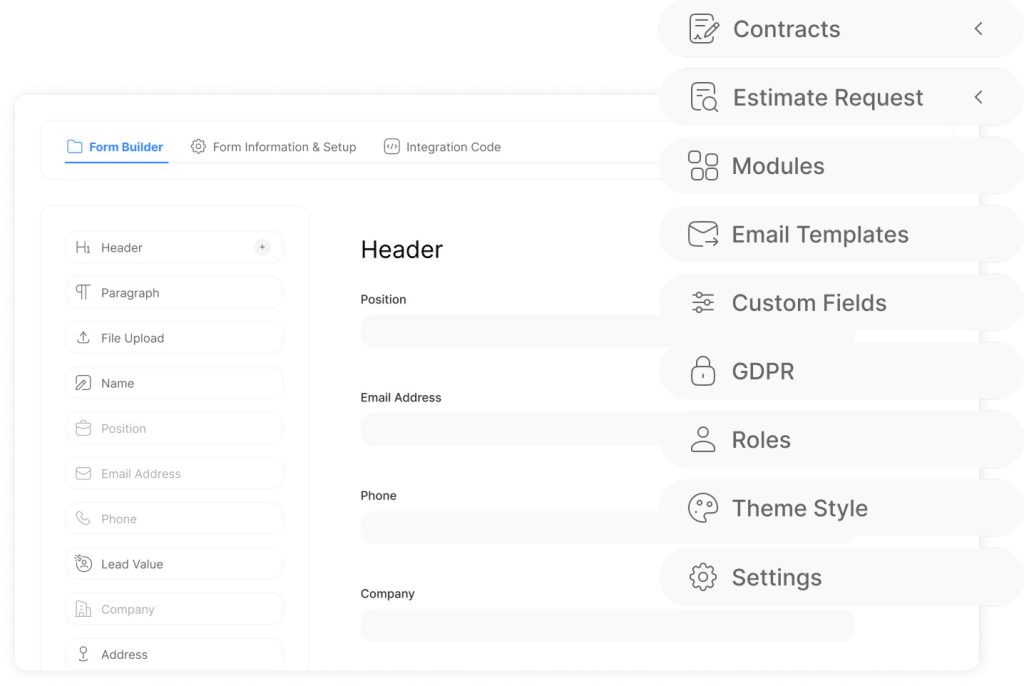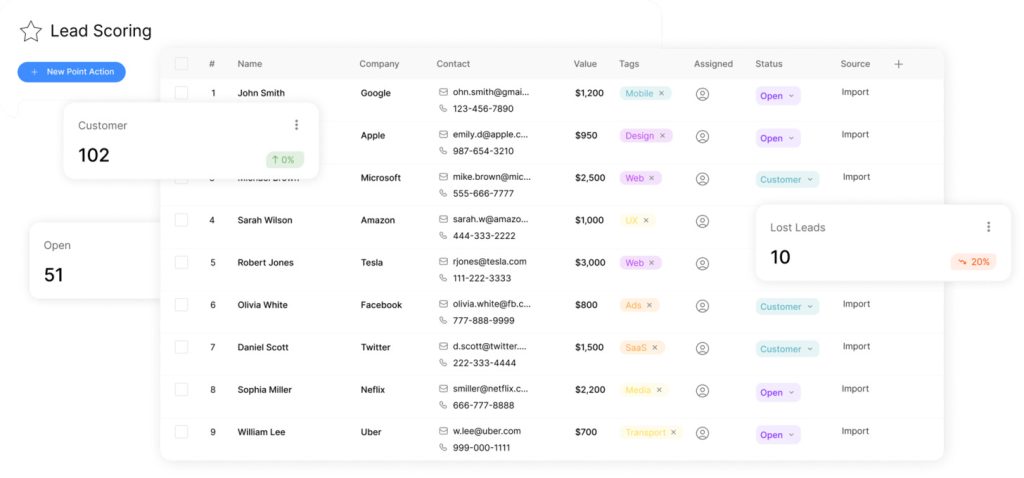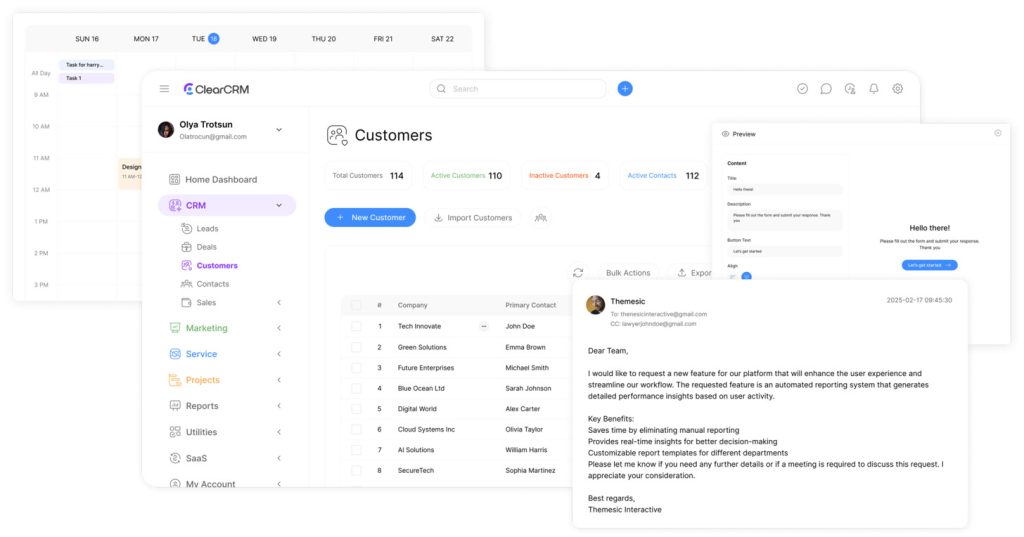Quick Lead Capture Forms for Better Lead Capture and Conversion

In today’s digital landscape, businesses are constantly seeking ways to enhance customer relationships and streamline operations. One crucial strategy involves leveraging lead capture forms on your website or blog to collect contact information and create instant CRM records.
But here’s the question: Are your current methods truly effective? Effective lead capture is about striking a balance between gathering necessary information and providing a seamless user experience. When done correctly, it transforms anonymous visitors into identifiable leads that can be nurtured through your sales funnel.
Key Takeaways
- Lead capture forms serve as a critical bridge between potential customers and your business.
- Modern solutions integrate seamlessly with CRM systems, eliminating manual data entry.
- Effective forms balance information collection with a frictionless user experience.
- Various form types and placement strategies can motivate visitors to share contact details.
- Optimizing lead capture forms can significantly enhance conversion opportunities.
The Power of Lead Capture Forms for Business Growth

Lead capture forms serve as a gateway to transforming anonymous website traffic into valuable leads. By implementing these forms, businesses can significantly enhance their lead generation efforts.
What Are Lead Capture Forms?
Lead capture forms are tools used on websites to collect information from visitors, typically in exchange for something of value such as a newsletter, eBook, or webinar. These forms capture contact details, enabling businesses to follow up and nurture leads through the sales process.
Why Lead Capture Forms Are Essential for Your Business
Lead capture forms are crucial for business growth as they provide a systematic approach to converting website visitors into qualified leads. The benefits of using these forms include:
- Transforming anonymous website traffic into tangible business assets—qualified leads that can be nurtured through the sales pipeline.
- Providing critical first-party data that enables personalized marketing efforts, thereby increasing engagement and conversion rates.
- Creating a consistent lead flow even when marketing budgets fluctuate or market conditions change.
- Enabling sophisticated customer segmentation, allowing businesses to tailor their messaging and offers to specific audience segments.
- Bridging the gap between marketing and sales departments by providing qualified leads with sufficient information for meaningful follow-up.
By leveraging CRM automation and effective lead capture strategies, businesses can enhance their sales and customer retention capabilities, ultimately driving business growth.
Types of Lead Capture Forms to Consider

Lead capture forms are essential tools for businesses, and understanding the different types can significantly enhance their effectiveness. By choosing the right form, businesses can improve their lead generation efforts and ultimately drive growth.
In-Page Forms: Seamless Integration
In-page forms are embedded directly within a website’s content, providing a seamless user experience. These forms are less intrusive and can be designed to match the website’s aesthetic, making them a subtle yet effective way to capture leads. By integrating forms within relevant content, businesses can increase the likelihood of capturing visitor information when they are most engaged.
To maximize their effectiveness, in-page forms should be placed strategically, such as at the end of blog posts or within dedicated landing pages. They should also be kept short and simple to reduce friction and increase conversion rates.
Popup Forms: Attention-Grabbing Conversion Tools
Popup lead generation forms, on the other hand, make a more assertive entrance by appearing in a popup window. Often accompanied by enticing offers, these forms can significantly boost engagement. Popup forms create immediate visual focus by temporarily overlaying website content, making them impossible to miss and highly effective at capturing attention.
- Modern popup forms utilize sophisticated triggering mechanisms based on user behavior, such as exit intent, scroll depth, and time on page, to appear at optimal moments.
- Effective popup forms balance attention-grabbing design with respectful user experience, avoiding intrusive timing or difficult dismissal options.
- Variations include exit-intent popups, timed popups, scroll-triggered popups, and mobile-optimized formats, providing diverse channels to grow a leads database.
10 Best Practices for Creating Effective Lead Capture Forms
To maximize lead generation, it’s essential to follow best practices when designing lead capture forms. Effective lead capture forms are essential for turning visitors into customers.
Create Compelling Headlines and Copy
Crafting compelling headlines and copy is essential to capture potential leads’ attention. Your headline should be clear, concise, and relevant to your target audience.
Using action-oriented language can significantly enhance the effectiveness of your lead capture forms. Ensure that your message resonates with your audience’s needs and interests.
Keep Forms Short and Simple
Simplifying your lead capture forms can lead to higher conversion rates. Limit the number of fields to the essential information required.
Short forms reduce friction and make it easier for visitors to complete the form, thereby increasing the likelihood of capturing leads.
Include Strong Calls to Action
A strong call-to-action (CTA) is critical for encouraging visitors to submit your lead capture form. Use action-oriented language that clearly communicates the benefits of filling out the form.
Ensure your CTA stands out visually and is placed prominently on your page to maximize its impact.
Strategic Form Placement
The placement of your lead capture form can significantly impact its effectiveness. Consider placing forms on high-traffic pages or using pop-ups to capture attention.
Strategically placing your forms where they are most likely to be seen can enhance their visibility and conversion rates.
Use Relevant Form Fields
Only ask for information that is necessary for your follow-up actions. Using relevant form fields helps in maintaining the quality of leads.
Add Interactive Elements and Images
Incorporating interactive elements and images can make your lead capture forms more engaging. This can include animations, videos, or relevant graphics.
Include Privacy Policies
Transparency about how you will use the information collected is crucial for building trust with potential leads. Clearly state your privacy policy.
Ensure Form Security
Securing your lead capture forms is essential for protecting sensitive information. Implement HTTPS and ensure compliance with relevant data protection regulations.

Set Up Post-Submit Follow-Up
After a visitor submits your form, a follow-up action can help in nurturing the lead. This could be a thank-you page or an email confirmation.
Test and Optimize Your Forms
Continuous testing and optimization of your lead capture forms are crucial for improving their effectiveness. Use A/B testing to identify the best-performing elements.
- Continuous testing can yield significant improvements in conversion rates.
- A/B testing helps isolate variables to identify specific improvements.
- Focus on both quantity and quality metrics to ensure balanced optimization.
- Prioritize testing high-impact elements first.
- Establish a regular testing calendar for ongoing improvement.
5 Inspiring Lead Capture Form Examples
The right lead capture strategy can make all the difference, as seen in these five standout examples. Effective lead capture forms are crucial for converting visitors into potential customers.
Obvi’s Weekly Giveaway Campaign
Obvi’s weekly giveaway campaign is a great example of using contests to capture leads. By offering a chance to win a product every week, Obvi creates a recurring incentive for visitors to provide their contact information. This approach not only generates leads but also engages potential customers.
Key Takeaway: Regular giveaways can keep your audience engaged and interested in your brand.
Native Deodorant’s Product Demo Offer
Native Deodorant effectively uses a product demo offer to capture leads. By allowing potential customers to experience their product, they build trust and increase the likelihood of conversion. This strategy is particularly effective for products that offer a unique solution or benefit.
- Demonstrates product value
- Builds trust with potential customers
- Increases conversion rates
Ecommerce Influence’s Value-Packed Popup
Ecommerce Influence uses a value-packed popup to capture leads. Their popup offers significant value in exchange for contact information, making it an attractive proposition for visitors. This strategy is effective for businesses looking to quickly grab the attention of potential customers.
The key is to ensure the offer is relevant and valuable to your target audience.
Fuller’s Flips’ Before-and-After Showcase
Fuller’s Flips showcases dramatic before-and-after results to capture leads. By visually demonstrating the effectiveness of their service, they create a compelling reason for visitors to provide their contact information. This approach is particularly effective for service-based businesses.
Visual storytelling can be a powerful tool in lead capture.
Earthlove Box’s Free Gift Incentive
Earthlove Box nails their lead capture popup by offering a “FREE Gift”. This makes their customers excited to sign up, so they can get their free serum in the mail. Earthlove Box demonstrates the enduring effectiveness of the free gift incentive, offering tangible value in exchange for contact information.
- Leverages the psychological principle of reciprocity
- Showcases product quality through sampling
- Taps into the motivator of receiving something “FREE”
These examples illustrate diverse strategies for effective lead capture. By understanding what works for different businesses, you can tailor your approach to best suit your audience and goals.
How to Create Lead Capture Forms That Convert

Creating lead capture forms that convert requires a strategic approach. By understanding the key elements that drive conversions, businesses can design forms that effectively capture leads and drive growth.
Building Irresistible Offers
To create an effective lead capture form, you need to offer something valuable in return for the visitor’s information. This could be a free e-book, webinar, or discount. The key is to make the offer relevant and appealing to your target audience.
Use clear and compelling copy to communicate the value of your offer. Ensure that the benefits are clearly stated and that the visitor understands what they will receive.
Choosing the Right Lead Capture Software
Selecting the best lead capture form software is crucial for creating effective forms. Look for a tool that offers customizable templates, easy integration with your CRM, and advanced targeting options. OptiMonk is a popular choice that provides these features and more.
Step-by-Step Form Creation Process
Here’s a step-by-step guide to creating a lead capture form using OptiMonk:
- Pick a template that fits your needs from OptiMonk’s Template Library.
- Customize your popup using the drag-and-drop editor, ensuring it matches your brand identity.
- Set up triggering and targeting options to control when and to whom the form appears.
- Integrate your form with your CRM or email marketing tool to ensure seamless data flow.
- Activate your lead capture campaign and start generating leads.
By following these steps, you can create a lead capture form that effectively captures leads and drives conversions.
Advanced Strategies to Boost Lead Form Conversions

To optimize lead capture forms, it’s crucial to leverage advanced strategies that take into account the unique preferences and behaviors of different audience segments. By doing so, businesses can significantly enhance the effectiveness of their lead capture efforts.
Multi-Step Forms: Breaking Down the Process
Multi-step forms simplify the lead capture process by breaking it down into manageable steps, reducing friction and increasing the likelihood of completion. This approach helps to minimize form abandonment and can lead to higher conversion rates.
Gamification: Making Lead Capture Fun
Gamification involves incorporating game-like elements into the lead capture process to make it more engaging and interactive. By leveraging rewards, challenges, or interactive content, businesses can create a more enjoyable experience for their visitors, thereby increasing participation and lead generation.
Personalization Through Visitor Segmentation
Personalizing lead capture forms based on visitor segmentation allows businesses to tailor their messaging and offers to specific audience groups. Effective segmentation can be based on factors such as traffic source, visitor behavior, demographic data, and previous interactions. By acknowledging the specific context of each visitor, businesses can demonstrate relevance and significantly increase conversion rates.
- Display targeted lead capture forms with messaging and offers tailored to different audience segments.
- Use segmentation variables such as traffic source, visitor behavior, and demographic data to create targeted campaigns.
- Leverage progressive personalization to create increasingly relevant experiences for returning visitors.
Privacy Considerations for Lead Capture Forms
When implementing lead capture forms, it’s crucial to consider privacy implications to build trust with potential customers. By prioritizing privacy and obtaining consent, you can provide users with a more secure and trustworthy experience on your lead capture page.
Understanding GDPR, CAN-SPAM, and CASL Compliance
Compliance with regulations such as GDPR, CAN-SPAM, and CASL is essential for any business using lead capture forms. These regulations mandate that businesses obtain explicit consent from users before collecting and processing their data. For detailed information on our privacy practices, please review our Privacy Policy.
Building Trust Through Transparent Data Practices
Transparent data practices are essential for building audience trust. You can achieve this by:
- Providing clear, jargon-free explanations of how you’ll use and protect visitor information.
- Displaying privacy trust signals, including recognized security badges and HTTPS protocols.
- Offering granular consent options that allow visitors to choose their communication preferences.
- Establishing a customer-centric data policy that prioritizes visitor interests.
By implementing these strategies, businesses can create a foundation of trust that extends beyond the initial form interaction, ultimately enhancing the effectiveness of their lead capture efforts.
Testing and Optimizing Your Lead Capture Strategy
To enhance the effectiveness of your lead capture strategy, testing is essential. With tools like OptiMonk, you can easily A/B test your popups to identify top-performing variations.
A/B Testing Essential Elements
Effective A/B testing involves examining various elements of your lead capture form, including headlines, CTAs, and form fields. This helps identify which components drive the highest conversion rates.
Analyzing Results and Making Improvements
Analyzing test results goes beyond conversion rates. It involves examining quantitative data, such as completion rates and field abandonment, as well as qualitative insights from user feedback. Prioritize improvements based on impact and complexity to maximize ROI.
Conclusion: Transform Your Business with Effective Lead Capture
Lead capture forms represent a crucial opportunity for businesses to transform their marketing efforts. By implementing the strategies outlined in this guide, companies can create a sustainable competitive advantage through superior lead acquisition capabilities. Effective lead capture forms drive long-term business growth by consistently delivering qualified prospects. To maximize results, it’s essential to view lead capture as an ongoing process of refinement and optimization. By doing so, businesses can stay ahead of the curve and achieve significant growth.
FAQ
What is the primary purpose of using lead generation on a website?
How can I create an effective landing page for generating leads?
What are the best practices for designing a lead generation form?
How can I optimize my lead generation form for better conversions?
What is the importance of email marketing in lead generation?
How can businesses ensure compliance with regulations when collecting customer information?
What role does content play in lead generation?
How can businesses measure the effectiveness of their lead generation efforts?
These forms are designed to capture the contact details of potential customers, allowing businesses to follow up and nurture them through the sales process.Crafting compelling headlines and copy is vital for capturing the attention of potential leads.Transparent data practices are vital for building trust with your audience. This can be achieved by:

